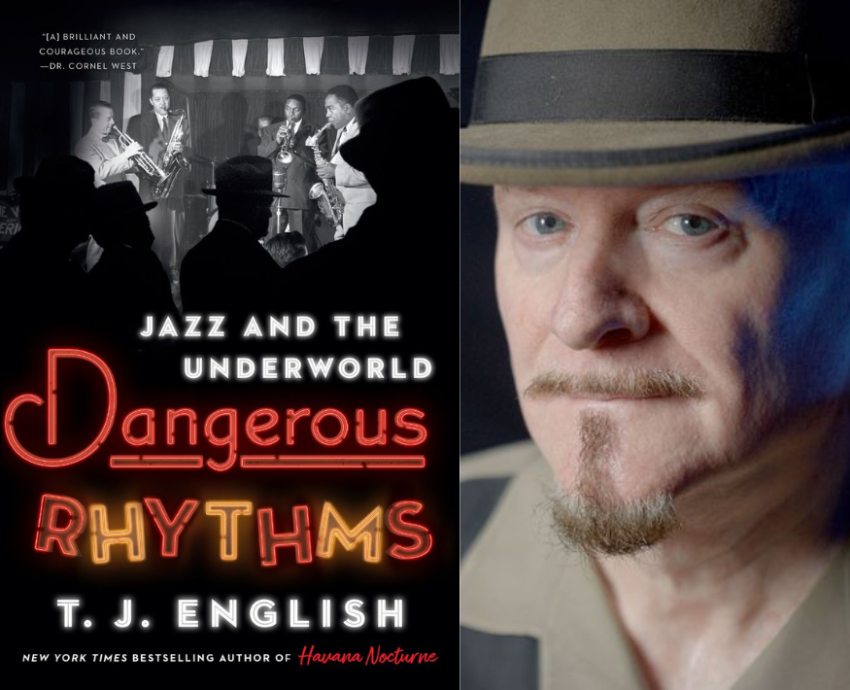
Dangerous Rhythms: Jazz and the Underworld
By TJ English
William Morrow/Harper Collins, 2022
422 pp
In TJ English’s enthralling new book, Dangerous Rhythms: Jazz and the Underworld, a cloud of menace and mayhem hangs over the story of how jazz music and organised crime evolved side-by-side in the United States.
English recounts how — by virtue of its origins in poverty, bordellos and other “rough and rowdy” venues, and owing to the coercive nature of cut-throat American capitalism — jazz and its practitioners necessarily were held in thrall to murderous thugs and their ruthless bosses.
Jazz has its origins in the post-Civil War culture of recent enslavement, lynching, denial of rights, Jim Crow segregation and hyper-exploitation. Because of this, jazz musicians suffered more dire — and more dangerous — “rites of passage” than many other artists. The arc of progress towards eventual “legitimacy” and liberation was a long and torturous journey over many lifetimes. The “plantation system” in jazz remained enforced until recently.
Dangerous Rhythms tells the story of how jazz artists endured, survived and eventually escaped this bondage. It is an inspiring and important story, which until now has not been fully explored.
English is a preeminent popular historian of organised crime in the US and a lifelong jazz aficionado, who hosts an occasional Latin jazz program in New York City.
He has written eight books and numerous magazine articles on the origins and development of various “outlaw” and “underworld” gangs and organisations, including the Italian mafia and its Irish, Jewish, Latin and Asian affiliates and imitators. Employing deep research and oral-history techniques, he has given us insightful stories about crooked police, Black and Cuban revolutionaries.
His reach is international and his perspective that of an engaged progressive investigator. Because most of the people discussed in Dangerous Rhythms are now dead, English shares his research into oral histories and other documentation to produce a smooth flowing, page-turning narrative. He has also provided a music soundtrack to accompany the book, available on Spotify, iTunes and his webpage.
Even well-informed jazz fans may be shocked to learn from Dangerous Rhythms that such internationally-famed stars as Louis Armstrong, Duke Ellington and Tony Bennett were held in thrall by mob “patrons” for most, or all of, their careers. Even Frank Sinatra came very close to being “rubbed out” by his mafia “pals” at one point in his career.
While English reveals that most performers accepted gangland supervision as the price of success in a dangerous and criminally-corrupted system, he does not sugar-coat the ugly side of this relationship. Al Capone may have enjoyed both opera and jazz, but he was also a vicious killer, who enforced his control of musicians like a “benevolent” slave-owner.
English cites the maiming and near-murder of musician/comedian Joe E Lewis as an example of what happened when the bosses became displeased with a favoured “employee”. Lewis escaped with his life but was held in thrall by the Las Vegas mob for the rest of his performing life. For decades, other artists saw what happened to Lewis as a warning and a threat.
There is a distinct class element to the story that English conveys. Jazz, like rock-n-roll and hip hop in later years, was looked down upon by the US ruling class. It was the music of the streets, of people of colour — not the preferred music of the snobbish WASP establishment.
Jazz was a people’s movement and — like it or not — the criminal mob was a part of that movement, just as it was a part of the union movement. English points out that many Italian mobsters, whose families had experienced racial and class prejudice, held a grudging affinity for Black musicians, while they denied Black fans entry into mob-owned and plantation-themed night clubs, such as the Cotton Club.
English traces the conjoined histories of American jazz and the criminal underworld in fascinating detail: from their origins in horrid urban ghettoes, through the mob-prosperous Jazz Age of Prohibition boot-legging, to the mob’s organisational spread across the US and even into pre-revolution Cuba. English then takes the reader on a journey into the modern jazz era, with its drug-trafficking, heroin-enslavement and destruction of great jazz artists such as Billie Holiday, Charlie Parker and Chet Baker, and into the present-day rise of jazz to “respectability”, by artists such as Wynton Marsalis.
Along the way, brave and defiant artists like Mary Lou Williams, John Coltrane and — to a degree — Miles Davis stand out as beacons of hope who foreshadowed how jazz would eventually outlive and escape the chains of the criminal “plantation”.
For all its detailing of grim reality, English said he sees Dangerous Rhythms as “a joyful history” describing and celebrating in detail the eventual progress of jazz and jazz artists from the slums of New Orleans to exalted venues such as the Lincoln Center and into mainstream documentaries by filmmakers such as Ken Burns.
The recordings of Louis Armstrong, Duke Ellington, Billie Holiday, Ella Fitzgerald, and so many others are timeless and enduring. And as English enthusiastically reminds us, jazz is a living art, still growing — particularly in its contemporary Latinx manifestation.
With English, the reader cannot help but rejoice in how this unique American art form and its practitioners have not only survived but triumphed. Dangerous Rhythms is a highly recommended and historically vital book.